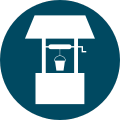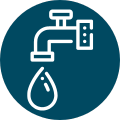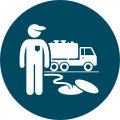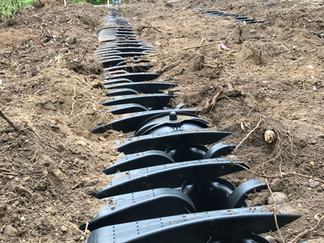
Our vision:
A safe and healthy Kitsap County for all.
Drinking Water & Onsite Sewage
Drinking Water & Onsite Sewage
Our Drinking Water and Onsite Sewage program help keep the Kitsap community safe by inspecting septic systems and offering free technical assistance to homeowners.
We also help make sure drinking water wells are properly located, designed, and built. Every well must offer enough water and must meet strict standards for safety and quality.
Additionally, we regulate over 800 small public water systems and provide resources on water quality issues, disinfection of water systems and protection of well sources from potential sources of contamination.
What You Need to Know About Properties Connected to a Septic System
A septic system is a critical part of a home. It collects, treats, and disposes of all water from toilets, sinks, tubs, showers, dishwashers, and other appliances.
Before buying or selling a home connected to a septic tank, make sure that you know the status of the septic system. Kitsap Public Health District can review records, inspect the system, and provide you with a written report of what we find. This is a great way to help protect your investment and follow regulations (Kitsap Public Health Board Ordinance 2008A-01, Section 13.D).
Before the final sale of a property, contact us for a property conveyance inspection (PCI) to identify any significant problems. Without an inspection, potential problems are not corrected and can cause major problems later on. For instance, a septic system my fail after new owners purchase a home, costing them thousands of additional dollars in repairs.
For us to perform a property conveyance inspection, we will need a record drawing. If your property does not have one, you will need to create one.
2024 Property Conveyance Inspection Findings
1,676 property conveyance inspections for septic were completed in 2024. Of those, 464 (28%) had significant deficiencies identified.
Avoiding Common Problems on Property Conveyance Inspections


Encroachment
Don’t build or park on your primary or reserve drainfield. Primary and reserve drainfield areas are intended to be maintained clear for maintenance and for future use.
Maintenance accessibility
For alternative systems, keep components accessible for maintenance.
Using beyond capacity or having unpermitted connections
Stay within the designed capacity of your drainfield design. To find out how many bedrooms your septic is approved for, search for your records through our GIS Search.
Do not add plumbing to outbuildings without project review and approval from Kitsap Health.
Compromised primary or reserve areas
Know where your septic areas are and protect them. To learn more about protecting those areas, review the Homeowner’s Guide
What You Need To Know About Properties Connected to a 1- or 2-party well or a Group B Water System
Effective March 4, 2019, all properties served by a Private or Group B Water System are required to have a Water Status Report from the Health District bfore they are sold.
Water Status Report applications (public and private) should be submitted 30 days before the property transfer to allow for any identified issues to be addressed before closing sale.
For more information, read our Private Water Status Report Frequently Asked Questions handout.
Just like a property conveyance inspection is important to know the status of a septic system, it is also important to evaluate your water system to identify significant problems.
2024 Private Water Status Report Findings
438 private water status reports were completed in 2024. Of those reports, 173 (39%) had significant problems identified.
Avoiding Common Problems on Private Water Status Reports
Construction Standards
Keep your well-head above grade and accessible (at least six inches above grade)


Well openings/access for contamination
Openings in the well casing/cap can allow contamination into the well. Ensure conduit, cap and all other entry points are sealed.
Ensure pressure tank maintenance is up to date and sample for bacteria annually. For more information about bacteria sampling, view our handout.

2024 Group B Water Status Report Findings
124 public water status reports for Group B systems were completed in 2024. Of those, 106 (84%) significant problems were identified.
Avoiding Common Problems on Public Water Status Reports
No user agreement
Group B user agreements have been required since 2019. All water systems should review their current user agreement or, if there isn’t one, create one. Learn more:
No operating permit
Group B water systems must have a current operating permit. Ensure water system contact information is up to date and the permits have been paid. For more information, visit our Group B Public Water Systems page.
No current samples
Most Group B water systems must sample annually for bacteria and every three years for nitrate. If you’re unsure of your sampling frequency or need technical assistance with taking samples, please call us at 360-728-2235 and ask to speak to the Drinking Water Inspector of the Day.
Reminder cards are mailed approximately 30 days prior to sample due date. Please make sure your system contact information is up to date.
Septic Systems
Our inspectors work with homeowners and businesses to make sure each septic system is designed, installed, and maintained correctly. Safe septic systems help protect ground and surface water and reduce the spread of disease.
Do you own a septic system?
Septic systems can be complicated. Read the Homeowners Guide to Onsite Sewage Systems or give us a call at 360-728-2235 to get started!
Drinking Water
Does your drinking water come from a private well or a public water system?
It's important to know the source of your water so you can be confident that your water is safe and reliable.
Whether you are constructing a public water system or need a well inspection to sell your property, our goal is to help you have a safe supply of water.
Kitsap Public Health District safeguards water for Kitsap residents by conducting routine inspections according to local and state regulations. We also work to ensure drinking water wells are properly located, designed, and built, while producing an adequate supply of water that meets strict standards for safety and quality.
Private well: serves up to two residential connections.
Public water system: any well that serves more than two residential connections. They are classified into two groups:
Group B systems serve between 3 and 14 connections.
Group A systems serve 15 or more connections or 25 or more people per day for 60 or more days a year.




















.png)
